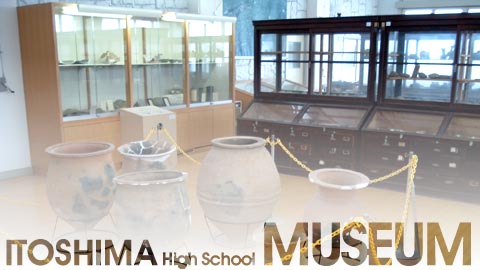■The outline of Itoshima high school Local Museum
 to Japanese INFORMATION
to Japanese INFORMATION

■About Itoshima high school Local Museum
Since the days of middle school under the prewar system,many historical materials and artifacts had been excavated and gathered to Itoshima high school which located at the place of Ito state described in the "Gishi"section of Chinese book"History of the Three Kingdom".After the Second World War,Mr.Dairoku Harada who had been deeply associated with this project since its foundation, he continued devoted and energetic work on classification and preservation of many artifacts gathered.
Moreover,with supports of activities of history club members,the explanation to the exhibits and the guide to the regional room became more satisfactory. Those days,the regional room was highly praised as said,"The regional room is more excellent than the college of America", or"When staying in the regional room,we can experience the ancient life of Itoshima coming up in our mind." or"The fruit of long united effort within school produced the regional room called "The best one of all nation". In May,1956 when the building used for both a gymnasium and an audiovisual room was completed,the audiovisual room of middle school under the prewar system was converted into a library.
On the second floor of a part of the library,Local Museum was born and designated by Ministry of Education as a facility "equivalent facility of museum"in October,1956. This is the way in which the only "Museum attached to high school designated by the Ministry of Education" was born. In 1988,the Local Museum was moved to the joined room extended on the 3rd floor of building including audiovisual room.
■The out line
Kofun period(300-710)is the protohistoric period which big tomb(kofun)were built for deceased members of the ruling elite. While Yayoi period(300BC-300AD)is grasped as the period of drastic change of life based on the rice agriculture,kofun period is recognized as the one of the great change of social system. In the final analysis,the movements of the people were more active and wider toward forming an ancient state.The symbol of kofun period is a unique tomb shaped like an old-fashioned keyhole. About 50 keyhole-shaped mound have been discovered in Itoshima until now. The number of those discovered in Fukuoka Prefecture is said to total 200,which means that the number of those discovered in Itoshima alone accounts for one fourth of all discovered in Fukuoka Prefecture. The Key hole-shaped mound is not only the tomb of local leaders but the evidence of the leader of the early Yamato State concluding pacts with the local leaders such as a leader of Ito state.
This means that Ito state enjoyed the close relationship with the early Yamato State and that Ito state was assured the position of the leader in the northern area of Kusyu island by the Yamato State. In the Local Museum of Itoshima high school,bronze mirrors,stone-carved jewelry and clayfigurines("haniwa")etc are being exhibited, which indicates the prosperity of ancient Ito state.
In the last term of kofun period,many grave holding the stone chambers with horizontal entrance passage were built,the number of which is said to be ranged from 500 to 1000. This explosive increase of the number of graves show that social circumstances changed around "kofun" changed and that the role of the kofun also changed. Most of them became small scale and had been already opened in the old times with the results of many artifacts in them excavated.
"Sue"ware,Korean style gray stone ware, was the one of the gratest number of artifacts among the early displayed ones in the Local Museum was probably discovered in the stone chamber of such a small grave. There are also artifacts among them which are thought to be imports from Korean Peninsula.
There are other unique artifacts which attracts interests of many people,such as a pottery excavated from Nagano kofun on which person figure was drawn and a earthen made doll excavated from Mitoko Matubara remain,which reminds us of expression and behavior of the people in the ancient times. |郷土博物館の経緯・概要|館内案内|歴史部のあゆみ|主な収蔵品(1)|主な収蔵品(2)|主な収蔵品(3)|主な収蔵品(4)|主な収蔵品(5)|主な収蔵品(6)|